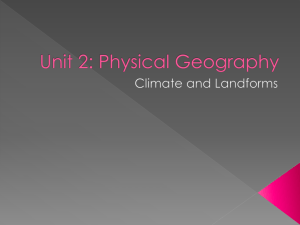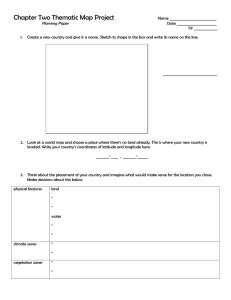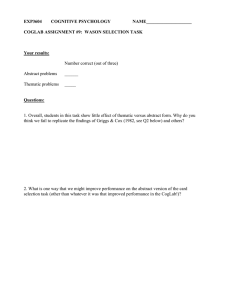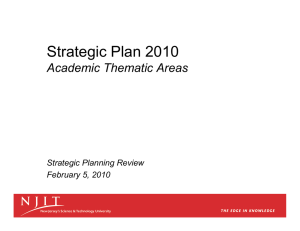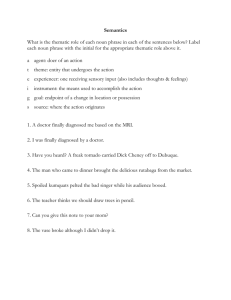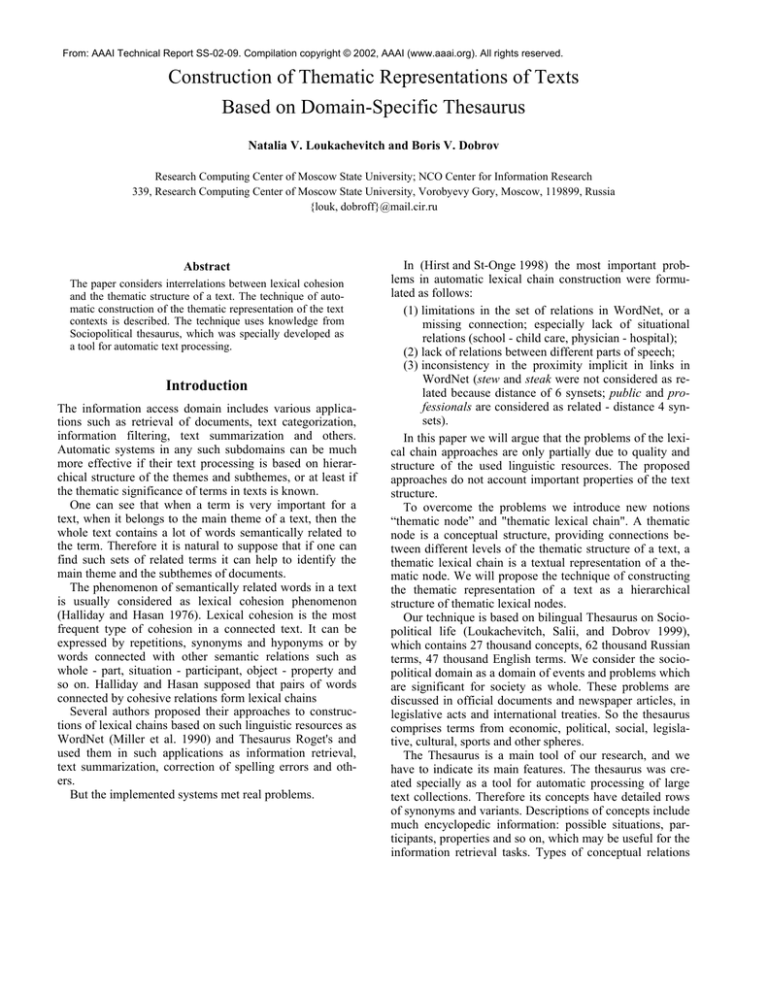
From: AAAI Technical Report SS-02-09. Compilation copyright © 2002, AAAI (www.aaai.org). All rights reserved.
Construction of Thematic Representations of Texts
Based on Domain-Specific Thesaurus
Natalia V. Loukachevitch and Boris V. Dobrov
Research Computing Center of Moscow State University; NCO Center for Information Research
339, Research Computing Center of Moscow State University, Vorobyevy Gory, Moscow, 119899, Russia
{louk, dobroff}@mail.cir.ru
Abstract
The paper considers interrelations between lexical cohesion
and the thematic structure of a text. The technique of automatic construction of the thematic representation of the text
contexts is described. The technique uses knowledge from
Sociopolitical thesaurus, which was specially developed as
a tool for automatic text processing.
Introduction
The information access domain includes various applications such as retrieval of documents, text categorization,
information filtering, text summarization and others.
Automatic systems in any such subdomains can be much
more effective if their text processing is based on hierarchical structure of the themes and subthemes, or at least if
the thematic significance of terms in texts is known.
One can see that when a term is very important for a
text, when it belongs to the main theme of a text, then the
whole text contains a lot of words semantically related to
the term. Therefore it is natural to suppose that if one can
find such sets of related terms it can help to identify the
main theme and the subthemes of documents.
The phenomenon of semantically related words in a text
is usually considered as lexical cohesion phenomenon
(Halliday and Hasan 1976). Lexical cohesion is the most
frequent type of cohesion in a connected text. It can be
expressed by repetitions, synonyms and hyponyms or by
words connected with other semantic relations such as
whole - part, situation - participant, object - property and
so on. Halliday and Hasan supposed that pairs of words
connected by cohesive relations form lexical chains
Several authors proposed their approaches to constructions of lexical chains based on such linguistic resources as
WordNet (Miller et al. 1990) and Thesaurus Roget's and
used them in such applications as information retrieval,
text summarization, correction of spelling errors and others.
But the implemented systems met real problems.
In (Hirst and St-Onge 1998) the most important problems in automatic lexical chain construction were formulated as follows:
(1) limitations in the set of relations in WordNet, or a
missing connection; especially lack of situational
relations (school - child care, physician - hospital);
(2) lack of relations between different parts of speech;
(3) inconsistency in the proximity implicit in links in
WordNet (stew and steak were not considered as related because distance of 6 synsets; public and professionals are considered as related - distance 4 synsets).
In this paper we will argue that the problems of the lexical chain approaches are only partially due to quality and
structure of the used linguistic resources. The proposed
approaches do not account important properties of the text
structure.
To overcome the problems we introduce new notions
“thematic node” and "thematic lexical chain". A thematic
node is a conceptual structure, providing connections between different levels of the thematic structure of a text, a
thematic lexical chain is a textual representation of a thematic node. We will propose the technique of constructing
the thematic representation of a text as a hierarchical
structure of thematic lexical nodes.
Our technique is based on bilingual Thesaurus on Sociopolitical life (Loukachevitch, Salii, and Dobrov 1999),
which contains 27 thousand concepts, 62 thousand Russian
terms, 47 thousand English terms. We consider the sociopolitical domain as a domain of events and problems which
are significant for society as whole. These problems are
discussed in official documents and newspaper articles, in
legislative acts and international treaties. So the thesaurus
comprises terms from economic, political, social, legislative, cultural, sports and other spheres.
The Thesaurus is a main tool of our research, and we
have to indicate its main features. The thesaurus was created specially as a tool for automatic processing of large
text collections. Therefore its concepts have detailed rows
of synonyms and variants. Descriptions of concepts include
much encyclopedic information: possible situations, participants, properties and so on, which may be useful for the
information retrieval tasks. Types of conceptual relations
originate in the relations of conventional informationretrieval thesauri (broader term – narrower term, related
term). In our thesaurus broader-narrower relations can be
marked with modifiers to describe multiple inheritance.
Most of the symmetric Related-Term relations of conventional information retrieval thesauri are described as nonsymmetric dependency relations. Dependency relations
describe how existence of a concept (or examples of a concept) depends on existence of another concept (or its examples) (Guarino 1998). The thesaurus relations have such
properties as symmetry, transitiveness, inheritance.
Automatic Construction of Lexical Chains
Recent works simulated lexical cohesion, constructing
'lexical chains'. A lexical chain is a chain of words in
which the criterion for inclusion of a word is some kind of
cohesive relationship to a word that is already in the chain
(Morris and Hirst 1991). Morris and Hirst also proposed a
specification of cohesive relations based on Roget's Thesaurus.
Hirst and St-Onge (1997), Barzilay and Elhadad (1997)
construct lexical chains based on WordNet relations. Definition of lexical cohesion relations based on WordNet includes extra-strong, strong and medium-strong relations.
Every next relation is weaker than previous one. Mediumstrong relations include paths of the WordNet conceptual
structure with maximum 5 links and have a specific form:
“UP--..--UP”,
“DOWN--..--DOWN”,
“UP--…
-…--DOWN”, “UP--…--HORIZONTAL--…--DOWN”.
The main stages in the proposed construction of lexical
chains are as follows:
- the construction of lexical chains begins from the first
words of a text;
- to insert the next word, its relations with members of
existing lexical chains are checked.
If there are such relations with any element of a chain
then the new word is inserted in the chain. Only one lexical
chain can be chosen. Among several possible lexical
chains a lexical chain with maximal weight of a relation
with a current word is chosen. For strong relations and
medium-strong relations there are restrictions on distance
between a current word and existing lexical chains.
We tried to repeat the described process with human experts. An expert received sentence by sentence from a text
and had to construct lexical chains. The main contents of a
text was not known to an expert. In this process any decision on nontrivial connection (not repetitions, hyponyms
and hypernyms) was a real problem. When the main contents of a text was known to experts (after several times of
rereading), then it seemed to be much easier to make decisions.
A human needed overall information about the text
contents, but the algorithm do not use any information
about the whole text. In fact, it looked like a circle. We
need lexical chains to find the main theme of a text, but the
main theme considerably influences process of lexical
chain construction.
There is another problem. What happens if this algorithm has additional situational relations. Let us take text 3
from text collection of Barzilay used in experiments on
lexical
chain
construction
(www.cs.columbia.edu/
nlp/summarization-test/index.html). The beginning of this
text is as follows:
Example1. Partying post-op (Text3)
COMPANIES that announce breakthroughs in
medical science usually get a hero's welcome. But
whereas surgeons applauded when Health Care International ( HCI ), a private hospital, announced this
month that one of its doctors had invented an anaesthetic machine which means people feel much less
sick after operations and speeds their recovery, reaction in Scotland was less than ecstatic.
In 1994, HCI opened a swanky 240-bed private
hospital to do expensive surgery on rich foreigners at
Clydebank in Glasgow. Though it promised hundreds
of jobs in an area of long dole queues, it went straight
to the top of the local hate list...
We take deficient situational relations from Thesaurus
on Sociopolitical life (Loukachevitch, Salii, and Dobrov
1999). Situational relations described in the Thesaurus can
be hierarchical or horizontal. Therefore we can repeat exactly the same algorithm of constructions of mediumstrong relations as described.
In the first paragraph of the text we can see the following terms from medical domain: medical science, surgeons, health care, hospital, doctor, anaesthetic, sick, operation. In the Thesaurus we can find the following paths
of relations, consisting of hyponymy-hypernymy relations
and situational relations. All forms of the paths are allowable by the described algorithm:
Surgeon -- UP -- doctor -- UP -- medical field -DOWN -- medical science;
Health care -- DOWN -- medical field -- DOWN -medical science;
Hospital -- UP -- medical organization -- UP -medical field -- DOWN -- medical science;
Doctor -- DOWN -- surgeon;
Anaesthetic -- UP -- medical help -- UP -- medical
field -- DOWN -- medical science
Sick -- UP-- health problems -- DOWN -- medical
field -- DOWN -- medical science
Operation -- UP -- surgery -- DOWN -- surgeon.
Existence of such paths means that all medical terms of
this text are be elements of the same lexical chain. All
terms are situated very close to each other. Differences in
weights of cohesion relations do not work, because there is
no alternatives. But such a lexical chain does not correspond to the main theme of the text.
An expert proposed the following formulation of the
main theme: “A private hospital Health Care International
invented an anaesthetic machine, which allows patients
feel much less sick after operations”. So the situation, described in the text, includes at least four important
“medical” participants, playing quite different roles in the
situation: hospital, anaesthetic, patient, operation. Therefore the results of the lexical chain construction misrepresent the thematic structure of the text.
In fact, the same problem can appear in processing of
any text within any domain. Let us see, for example, next
text of the collection “A shortage of sirs” discussing
“shortage of teachers at schools of Britain”.
The beginning of the text is as follows:
Example 2. Teaching
A shortage of sirs
TRYING to teach quadratic equations to a bunch of
unruly teenagers is hardly the cushiest of jobs. So as
unemployment continues to fall, it is not surprising
that teacher-training colleges are finding it hard to
recruit prospective maths teachers. But there are
growing worries that the supply of teachers may be
dwindling just as the number of school-age children is
growing…
Again teacher and school are very related words. But in
this text they have to be represented as different entities in
the thematic structure, because the relation between them
is in the focus of the text.
Thus the approach does not explain two interdependent
phenomena:
1) why experts need information about the whole text to
identify cohesion relations;
2) why very related terms are separated in the thematic
structure of some texts.
Thematic Structure
and Thematic Lexical Chains
The described approach to lexical chain construction
searches relations between sentences of a text. But such
relations can be as far from the thematic structure of a text
as superficial syntactic relations from deep semantic relations. However, the primary goal of the most information
retrieval applications is to recover the thematic structure of
texts and to use it for effective text processing. Therefore it
is necessary to analyze facts known about the thematic
structure.
Van Dijk and Kintsch (1983) describe the topical structure of a text, the macrostructure, as a hierarchical structure
in a sense that the theme of a whole text can be identified
and summed up to a single macroproposition. The theme of
the text can be usually described in terms of less general
themes which in turn can be characterized in terms of even
more specific themes, and so on. Every sentence of a text
corresponds to a subtheme of the text.
This means that a connected text has its main theme and
this main theme can be formulated. Let us take the Example1 and the formulation of its main theme (see previous
section). The formulation of the main theme names the
most important concepts or objects of the text (the main
concepts of the text) such as hospital, machine, anaesthetic, patient, operation and indicates relations between
them. (We imply that the thematic structure is a structure
of concepts and specific objects, not words. Therefore here
and below when we say 'concepts of a text' we imply concepts, the text variants of which were mentioned in a text).
The subthemes of the texts have to describe some of the
main concepts or relations between them. Therefore if it is
required to find the subthemes of a text it is necessary to
formulate the main theme of a text, identify the main concepts of the text; construct singles, pairs, triples from the
main concepts as names of the subthemes and find corresponding sentences.
So all main concepts from the formulation of the main
theme of the Example1 are supported with several sentences.
For example, there is a subtheme and corresponding
sentences describing the hospital: In 1994, HCI opened a
swanky 240-bed private hospital to do expensive surgery
on rich foreigners at Clydebank in Glasgow….
Another subtheme describe relations anaesthetic -- machine -- patient:
1)… one of its doctors had invented an anaesthetic
machine which means people feel much less sick after
operations and speeds their recovery.
2)But Mr Kenny's device uses two micro-computers
to achieve much closer monitoring of the pump feeding the anaesthetic into the patient and others.
At the same time we can find several sentences and
clauses, presence of which in the text is difficult to explain
on the basis of the proposed formulation of the main
theme:
1) reaction in Scotland was less than ecstatic.
2) Though it promised hundreds of jobs in an area
of long dole queues, it went straight to the top of the
local hate list.
3) The Edinburgh house in which Sir James Young
Simpson, another Scottish doctor, discovered the first
modern anaesthetic, chloroform, in 1846 has a commemorative plaque on it. Mr Kenny may eventually be
as esteemed as Sir James. But whether his innovation
encourages the Scots to pay more regard to HCI remains to be seen.
These clauses and sentences describe relation of Scottish
people to the hospital and the invention. It allows us to
suppose that such important concept as SCOTLAND was
missed in the formulation of the main theme.
Thus every sentence has correspondence with a subtheme, every subtheme has a corresponding fragment in a
formulation of a subtheme of upper level or the main
theme.
To refer to the main theme a subtheme has to include a
main concept or its related concept; in sentences of a text
such references look like lexical cohesion relations. For
example, the subtheme anaesthetic – machine includes the
following sentence with reference words device and microcomputer:
But Mr Kenny's device uses two micro-computers
to achieve much closer monitoring of the pump feeding the anaesthetic into the patient.
Word anaesthetists refers to anaesthetic: Anaesthetists
who have either tried the machine, or seen it demonstrated
at medical conferences, are enthusiastic.
Therefore sets of lexically related words in a text play a
very important role. They provide references from the
lower levels of the thematic structure of a text to the upper
levels of subthemes and to the main theme. Every such
reference has its specific referent – a concept of upper
level.
On the other hand every main concept or a concept of
upper levels of the thematic structure has a set of related
concepts, text variants of which were used for reference on
it in a text. Such a set looks like a node. It has its center
and all other its concepts are semantically related to the
center. Therefore we called such sets “thematic nodes”.
Thematic nodes have inseparable relations with the thematic structure of a text and definite functionality within it.
So the concepts of a text can be divided to thematic nodes.
In a text the text variants of the same thematic node look
like sets of semantically related words but the main property of words in such sets is their relatedness to the same
concept. Textual representation of thematic nodes is called
“thematic lexical chain”. A thematic node and a thematic
lexical chain that have a main concept of a text as a thematic center are called “main thematic node” and “main
thematic lexical chain”, respectively.
Thus, in our opinion, sentences in a coherent text can be
superficially connected by various means such as pronouns, cue words, pairs of related words. But sets of related words in different sentences of a text, which look like
lexical chains, have tense functional relations with the
thematic structure – they provide connections between
different levels of the thematic structure. Such sets have
their own internal conceptual form – form of thematic
nodes.
Properties of Main Thematic Nodes
From the consideration of relationships “the main theme -subthemes -- sentences -- related words” two important
consequences follow. At first we can formulate a very important principle how to find main concepts of a text, that
is how to distinguish main thematic nodes from other thematic nodes.
The main theme of a text usually includes several main
concepts. The text discusses relations between the main
concepts, that is, there are subthemes which devoted to
discussing a specific relation. Therefore combinations of
such main concepts and their related concepts have to often
occur together in clauses and sentences of the text. They
have to occur together more often than concepts belonging
to other thematic nodes. If there are n main concepts in a
text, then the sum of frequencies of mutual cooccurrence of
concepts of different main thematic nodes have to be more
than sum of frequencies of other n thematic nodes. Otherwise the formulation of the main theme was not correct.
This feature of main thematic nodes allows their recognizing among thematic nodes of other terms for texts of
any size and different genres.
As the second consequence we can formulate a very important restriction on the membership in a thematic node.
Two concepts of a text (even very semantically related
concepts) can not be considered as elements of the same
thematic node if they often co-occur in the text. Indeed,
frequent cooccurrence means that a relation between the
concepts is an important point of discussion in the text. If
frequency of their mutual cooccurrence is maximal or
comparable with maximum cooccurrences of other pairs of
concepts in the text, it possibly means that the relation
between the concepts is a focus of the whole text, and both
concepts C1 and C2 are main concepts of the text. The
relatedness of concepts does not disappear. But the concepts are considered as different entities contrapositive to
each other. Therefore it is impossible to gather these concepts in the same thematic node, otherwise the thematic
structure of the text is distorted.
Such situation can be seen in Example2. Concept
teacher was mentioned 24 times. Concept school – 9 times.
At least 7 times they were mentioned near each-other. This
is maximum frequency of mutual cooccurrence for the text,
and the both concepts were in the main theme of the text.
In the Example1 pair hospital – patient (which often
considered as a pair of related concepts) coocurs 3 times,
pair anaestetic – patient 4 times (the maximum frequency
is 6 of pair patient – machine). So these values of cooccurrence are significant for the text
So in this examples we can really see interdependence
between frequency of cooccurrence of two concepts in a
text and the thematic structure of a text.
Thus our conclusion is as follows: the more frequency of
mutual cooccurrence of two concepts in a text, the more
importance of discussion of the relation between the concepts, the more necessity to include the concepts in different thematic nodes. And vice versa if frequently mentioned
concepts are relatively rarely met near each other, it can
evidence in favor of their semantic relatedness and necessity to include them in the same thematic node.
The main thematic lexical chains in the Example1 are:
Machine (8): pump, device, computer, microcomputer, equipment, medical equipment
Anaesthetic (7): anaestetist, anaesthesia, drug,
chloroform
Patient (10): sickness, sick, people
Scotland (1): Glasgow, Scottish, Scots, Britain,
British
Hospital (6): HCI
Operation (3): surgery, surgeon, post-operative.
This set of main thematic lexical chains is a result of
manual analysis. In automatic processing relations machine
– medical equipment, anaesthetic – chloroform, operation
– surgeon, hospital – HCI were missed.
Practical Steps to Creation of Thematic
Nodes. Thematic Representation
The main stages of automatic constructions of thematic
nodes for a text, implemented in a real system are as follows:
1) To construct thematic nodes it is not necessary to
follow pairs of related words sentence by sentence. At first
it is necessary to identify suppositional centers of the thematic nodes. The main concept of a thematic node are
relatively more important than other concepts of the thematic node and has to be stressed in a text. It can be more
frequent than related concepts, can be used in the title or
subtitle of the text or be mentioned before other related
concepts.
A main concept is a member of the only thematic node.
Other concepts can be included in several thematic nodes
(in practical realization we used restriction “three thematic
nodes” as maximum). So concept anaesthetist in the Example1 refers not only to concept anaesthetic but also related to concept doctor.
All concepts of a text are ordered by their initial weight
(frequency, title). Every next concept that is not a member
of an existing thematic node can become a thematic center
of a new thematic node.
2) The chosen main concept collects all semantically
related concepts mentioned in the text. Definition of semantic relatedness is based on allowable thesaurus paths
with several restrictions. The restriction described in section3 is not yet implemented but it is simulated with restrictions in thesaurus paths (paths up-..- down are not
permitted). At the same time it is important to stress that
presence of situational relations in the Thesaurus provides
much more straight paths than in WordNet 1.6.
3) To estimate cooccurrrence of concepts of different
thematic nodes in a text, we use the notion 'textual relation': a given concept has textual relations with those concepts of the text that are located no further than three concepts of the Thesaurus from the given concept (location
order is not important).
Thus the context of a concept occurrence is determined
by the quantity of meaningful elements. Other words (not
from the Thesaurus) are not included in the count. Textual
relations pass through sentence borders and are interrupted
only by paragraphs.
4) In our approach the main thematic nodes are those
ones that:
- have textual relations with all other main thematic
nodes and
- have a sum of frequencies of textual relations between
these nodes that is greater than the sum of frequencies
for the same number of other thematic nodes of this
text.
More detailed description of the algorithm can be read in
(Loukachevitch and Dobrov 2000).
We incorporate constructed thematic nodes into the
‘thematic representation' of the text. The thematic representation of a text is a hierarchical structure of concepts
where concepts semantically related to thematic centers are
gathered in thematic nodes. Thematic nodes whose thematic centers can characterize the contents of a text are
main thematic nodes. A hierarchy of thematic representation characterizes the importance of concepts in the text:
the thematic center is more important than other concepts
of the thematic node; concepts of main thematic nodes are
more important than the concepts of other thematic nodes.
Thus all concepts of the text are divided into five classes
of different importance for the text:
- main concepts of main thematic nodes,
- other concepts of main thematic nodes,
- main concepts of specific thematic nodes,
- other concepts of specific thematic nodes,
- mentioned concepts.
More detailed description of the algorithm can be read in
(Loukachevitch and Dobrov 2000).
Evaluation of Applications Based
on Thematic Representation
We tested our approach for concepts of a text corresponding to the main theme of the text. Thus, we could test how
information, described in the Thesaurus, supported exposition of the main themes of various texts.
For every text we tried to choose three or four main concepts characterizing the main theme of the text in the best
way. We chose them mainly from the title, the first paragraph of the text or took the most frequent concepts manually.
At the second stage for each main concept we fulfilled
automatic procedure of construction of a thematic node.
Finally during manual reading we tested if every element of the thematic node really served for establishing
cohesive relations with the its thematic center. In this process we could compute precision and recall of the automatic
process of detection of lexical cohesion relations in texts.
After analysis of 73 main thematic nodes, serving for
organizing lexical cohesion relations in 25 texts of the sociopolitical domain, our results are as follows: precision –
89 %, recall - 71%.
The Thesaurus and the thematic representations of texts
are basic tools for organizing conceptual indexing and
ranged information retrieval, automatic text categorization
and text summarization in University information system
RUSSIA (www.cir.ru/eng), containing 300 thousand Russian documents. Calculation of weights of concepts in texts
is based on automatically constructed thematic representations of the texts.
To evaluate thesaurus-based information retrieval in UIS
RUSSIA we took 20 topics from list of “Subject Headings
for Legislative Acts” adopted as an official system of sub-
ject headings in the Russian Federation, includes 1168
subject headings and 20 main thematic subdivisions. The
topics for evaluation were randomly extracted from every
thematic subdivision (for example, “Water supply”, “Use
of nuclear energy”, “Migration of population”).
Every search was implemented twice. The first search
was implemented using vector model. In the second search
we manually represented a topic as Boolean expression of
words which are absent in the Sociopolitical thesaurus and
terms from the Thesaurus. Such translation was literal
without any additions or deletions. For example, subject
heading “Use of nuclear energy” was represented as “use
(word)” and “nuclear energy (term)”.
During search every term was automatically expanded
using its full thesaurus tree of hierarchy.
We used “3-point” evaluation to compute average precision for 0.2, 0.5, 0.8 recall values (Vorhees 1998), as a
single measure of retrieval effectiveness. Results of
evaluation were as follows:
Type of search
Vector Search
Thesaurus Search
0.2
0.77
0.81
0.5
0.52
0.58
0.8
0.02
0.46
Avg
0.44
0.62
Coverage of media texts by the thesaurus terms allowed
our text summarization system to receive qualitative results
in SUMMAC conference in 1998 (SUMMAC Final report
1998).
Acknowledgements. Partial support for this research is
provided by the Russian Foundation for the Humanities
through grant # 00-04-00272.
Conclusion. Challenge questions
The thematic representation model does not depend on
genre, size, domain or language of texts. It is “only” necessary to change a thesaurus if a domain or a language has
been changed.
The thematic representation is very illustrative. We
processed thousands of texts, looked through their thematic
representations, in order to test how the thematic representations correspond to the main themes of texts. Misrepresentation of the main theme in the thematic representation usually was due to mistakes in the thesaurus descriptions. At the first stages it was the most important factor
for correcting the thesaurus and even the thesaurus model.
For several years the thematic representation model and
the Thesaurus are intensively used in various applications
of automatic text processing of large text collections in
Russian and English, such as automatic conceptual indexing, information retrieval, knowledge-based text categorization and automatic summary construction.
In future we plan to study how to incorporate rhetorical
relations (Mann and Thompson 1988), resolution of pronoun anaphora, partial syntactic analysis into our technique
of analysis of the thematic structure of coherent texts.
References
Barzilay, R. and Elhadad, M. 1997. Using Lexical Chains
for Text Summarization. In Proceedings of ACL/EACL
Workshop Intelligent Scalable Text Summarization. Madrid.
Guarino, N. 1998. Some Ontological Principles for Designing Upper Level Lexical Resources. In Proceedings of
First International Conference on Language Resources and
Evaluation.
Halliday, M. and Hasan, R. 1976. Cohesion in English.
Longman, London.
Hirst, G. and St-Onge, D. 1998. Lexical Chains as representation of context for the detection and correction malapropisms. In Fellbaum C., editor, WordNet: An electronic
lexical database and some of its applications, 305-332.
Cambrige, MA: The MIT Press.
Loukachevitch N. 1998. Text Summarization Based on
Thematic Representation of Texts. In: Intelligent Text
Summarization - Proceedings of the AAAI’98 Spring
Symposium on Intelligent Text Summarization - AAAI
Technical Report SS-98-06, pp.77-84.
Loukachevitch, N.; Salii, A. and Dobrov, B. 1999. Thesaurus for Automatic Indexing: Structure, Developement, Use,
In Proceedings of International Congress "Terminology
and Knowledge Engineering", 343-355.
Loukachevitch, N., and Dobrov, B. 2000. Thesaurus-Based
Structural Thematic Summary in Multilingual Information
Systems. Machine Translation Review 11: 10-20. (see also
www.bcs.org.uk/siggroup/nalatran/mtreview/mtr-11/mtr11-8.htm)
Mann, W. and Thompson, S. 1988 Rhetorical structure
theory: Toward a functional theory of text organization.
Text 8(3): 243-281.
Miller, G.; Beckwith, R.; Fellbaum, C.; Gross, D.; and
Miller, K. 1990. Five papers on WordNet, CSL Report 43,
Cognitive Science Laboratory, Princeton University.
Morris, J. and Hirst, G. 1991. Lexical cohesion computed
by thesaural relations as an indicator of the structure of a
text. Computational Linguistics 17(1): 21-48.
The TIPSTER SUMMAC Text Summarization Evaluation.
Final Report 1998.MITRE Technical Report MTR
98W0000138
Vorhees, E. 1998. Using WordNet for Text Retrieval. In
Fellbaum C., editor, WordNet: An electronic lexical database and some of its applications, 285-303. Cambrige,
MA: The MIT Press.

